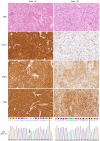Mutational characteristics of gastrointestinal stromal tumors: A single-center analysis of 302 patients
- PMID: 33552291
- PMCID: PMC7798044
- DOI: 10.3892/ol.2021.12435
Mutational characteristics of gastrointestinal stromal tumors: A single-center analysis of 302 patients
Abstract
Gastrointestinal stromal tumors (GISTs) represent a spectrum of tumors characterized by variable behaviors and activating mutations in KIT proto-oncogene, receptor tyrosine kinase (KIT) or platelet derived growth factor receptor α (PDGFRA) genes. However, whether genotype analysis should be regarded as a prognostic indicator remains unclear. In the present study, clinicopathological data and the mutation phenotypes of KIT and PDGFRA genes were assessed in a series of 302 patients with GISTs at a single center. Univariate and multivariate Cox regression analyses were performed to identify the clinicopathological and mutational factors associated with relapse-free survival (RFS) in patients who had undergone complete primary GIST resection. KIT and PDGFRA mutations were identified in 233 (77.2%) and 30 (9.9%) cases, respectively. The following clinicopathological parameters were significantly associated with a shorter RFS: Male, non-gastric tumor origin, larger tumor size (>5 cm), high mitotic activity (>5/50 high-power fields), necrosis and epithelioid morphology. Tumors at non-gastric sites, with high National Institutes of Health risk classification, high World Health Organization (WHO) grade and KIT deletion involving codons 557/558/559 exhibited a significantly higher risk of progression. In the Cox regression model, KIT deletion involving codons 557/558/559, non-gastric origin and high WHO grade were independent indicators of RFS. The adverse prognosis associated with KIT deletions involving codons 557/558/559 was also observed for gastric GISTs. Conversely, spindle morphology, KIT exon 11 substitution and PDGFRA exon 18 mutation were associated with a longer RFS and lower rate of relapse. Furthermore, the coexistence of KIT exon 11 deletion and exon 13 duplication was observed in one tumor, with adverse prognostic features. Heterogeneity affecting morphology, immunostaining and genotype was identified in 4 cases. In addition, the presence of succinate dehydrogenase-deficient GIST was found in 5 cases (3.6%). In conclusion, the tumor genotype with regard to KIT and PDGFRA mutations exhibited prognostic significance for the risk of GIST progression and may be helpful for the optimization of tailored adjuvant therapy.
Keywords: KIT; PDGFRA; gastrointestinal stromal tumors; heterogeneity; mutation.
Copyright: © Liang et al.
Figures




References
-
- Rossi S, Miceli R, Messerini L, Bearzi I, Mazzoleni G, Capella C, Arrigoni G, Sonzogni A, Sidoni A, Toffolatti L, et al. Natural history of imatinib-naive GISTs: A retrospective analysis of 929 cases with long-term follow-up and development of a survival nomogram based on mitotic index and size as continuous variables. Am J Surg Pathol. 2011;35:1646–1456. doi: 10.1097/PAS.0b013e31822d63a7. - DOI - PubMed
LinkOut - more resources
Full Text Sources
Other Literature Sources
Miscellaneous
